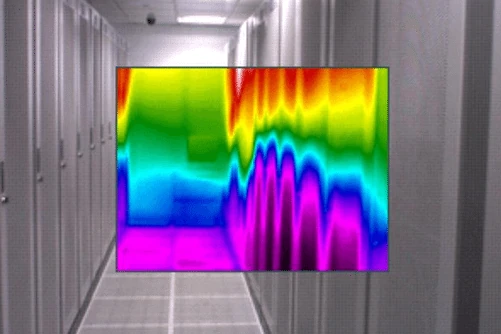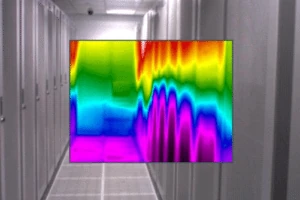4 Steps to Eliminating Exhaust Air Circulation14 min read

Exhaust air is part of the normal process and flow of IT equipment cooling, and if managed correctly, plays a vital role to ensure the efficiency of the cooling infrastructure. If not managed correctly, exhaust air circulation can occur, which can be very dangerous and bring on many problems in your data center.
When exhaust air circulation occurs, intake temperatures to IT equipment increase, significantly reducing the reliability of the equipment. In order to maintain reliability, it is required to either add cooling units or increase fan speeds to supply an adequate volume of conditioned air to properly cool the equipment. It also necessitates lowering temperature set points to overcome the mixing of supply and exhaust air and keeping intake air temperatures within desired limits. This ultimately results in higher operating expenses and wasted cooling capacity.
Causes of Exhaust Air Circulation
Exhaust air circulation is caused by any openings in the racks or aisles which allow hot exhaust air to pass from the hot aisle to the cold aisle before returning to a cooling unit. It can occur when there are unsealed gaps in any of the following areas:
- Open U-spaces
- Between vertical rails (inside the cabinets)
- Sides of cabinets
- Between adjacent cabinets
- Over cabinet tops
- Under cabinets
- Around row ends
This may seem a little overwhelming, but it can easily be contained through proper airflow management.
Steps to Eliminate
- Seal gaps within the rack. This includes sealing all open U spaces and side rails in every cabinet. While installing blanking panels is a common best practice, it is surprising how many sites still have not achieved 100% blanking panel use. Also, most blanking panels available do not seal effectively. Many leave a 1/16” to 1/8” gap between adjacent panels. Even at just a 1/16” gap between panels in a 42U cabinet filled with blanking panels there will be 45.5 in² area left open (41 spaces x 17.75” between rails x 0.0625” gap = 45.5 in²). This is equivalent to the open area of 1.5 missing blanking panels.
Also very important is sealing the open space between the rails and the sides of cabinets. In some cabinets this space is sealed by design, however in many it is left open. Often blanking panels have been installed but this space remains open becoming the primary location of both exhaust air circulation to the front of the cabinet or loss of conditioned airflow through the cabinet. In cabinets where this space has not been sealed there is often a 1.5” to 2” wide space the height of the cabinet. For a 42U cabinet there will be 220.5 in² area left open (42 spaces x 1.75” x 1.5” between rails and side of cabinet x 2 sides = 189 in²). This is equivalent to the open area of 6.1 missing blanking panels.
- Seal gaps between racks. Gaps between cabinets, often referred to as rack gaps, can occur when there is building column present in the row, cabinets have been removed from the row, or even in the case when a row is in the process of being built out. Whatever the case, sealing the gaps between racks is extremely important as all of these conditions result in higher operating expenses, wasted cooling capacity, as well as limited efficiency by allowing exhaust air circulation and/or the loss of conditioned air.
- Seal gaps under the rack. Often overlooked, the small space between the bottom of an IT rack or cabinet and the raised floor or slab can have a significant impact on IT inlet temperatures. This space allows for exhaust air circulation, as air from the hot aisle flows under the racks into the cold aisle where IT equipment at the bottom of racks pulls in the hot air. This leads to hotspots, which can ultimately lead to degradation of IT equipment.
- Seal the row. This includes sealing the end of rows and over cabinet tops. Sealing the end of rows/aisles is an essential step to ensure hot and cold aisle separation and eliminating exhaust air circulation. Due to the fact that cabinets at the ends of rows are the most vulnerable to increased intake temperatures because of the potential for hot exhaust air to wrap around the ends of the rows, this is more of a priority than you may think.Also essential to ensuring hot and cold aisle separation and eliminating exhaust air circulation is addressing the tops of cabinets. Perhaps the largest area for exhaust air to enter the cold aisle, cabinet tops should be addressed in both aisles. In hot aisles, vertical containment baffles are specifically designed to direct exhaust air to the ceiling plenum and away from the cold aisle. In cold aisles, while the primary objective of angled containment baffles is to contain supply air within the cold aisle, they also block exhaust air from entering, especially in cases when the hot aisle has not yet been addressed.
Conclusion
Exhaust air is part of the normal process of data center cooling, however if it is not managed correctly, it can cause many problems when allowed to circulate back into the cold aisle and through IT equipment before returning to a cooling unit. Properly managing the areas where exhaust air circulation can occur is essential to ensuring the reliability of IT equipment as well as reducing operating expenses, as extra cooling capacity is often required to mitigate the effects of exhaust air circulation.

Airflow Management Awareness Month
Free Informative webinars every Tuesday in June.

When exhaust air circulation occurs, intake temperatures to IT equipment increase, significantly reducing the reliability of the equipment. In order to maintain reliability, it is required to either add cooling units or increase fan speeds to supply an adequate volume of conditioned air to properly cool the equipment. It also necessitates lowering temperature set points to overcome the mixing of supply and exhaust air and keeping intake air temperatures within desired limits. This ultimately results in higher operating expenses and wasted cooling capacity.
Causes of Exhaust Air Circulation
Exhaust air circulation is caused by any openings in the racks or aisles which allow hot exhaust air to pass from the hot aisle to the cold aisle before returning to a cooling unit. It can occur when there are unsealed gaps in any of the following areas:
- Open U-spaces
- Between vertical rails (inside the cabinets)
- Sides of cabinets
- Between adjacent cabinets
- Over cabinet tops
- Under cabinets
- Around row ends
This may seem a little overwhelming, but it can easily be contained through proper airflow management.
Steps to Eliminate
- Seal gaps within the rack. This includes sealing all open U spaces and side rails in every cabinet. While installing blanking panels is a common best practice, it is surprising how many sites still have not achieved 100% blanking panel use. Also, most blanking panels available do not seal effectively. Many leave a 1/16” to 1/8” gap between adjacent panels. Even at just a 1/16” gap between panels in a 42U cabinet filled with blanking panels there will be 45.5 in² area left open (41 spaces x 17.75” between rails x 0.0625” gap = 45.5 in²). This is equivalent to the open area of 1.5 missing blanking panels.
Also very important is sealing the open space between the rails and the sides of cabinets. In some cabinets this space is sealed by design, however in many it is left open. Often blanking panels have been installed but this space remains open becoming the primary location of both exhaust air circulation to the front of the cabinet or loss of conditioned airflow through the cabinet. In cabinets where this space has not been sealed there is often a 1.5” to 2” wide space the height of the cabinet. For a 42U cabinet there will be 220.5 in² area left open (42 spaces x 1.75” x 1.5” between rails and side of cabinet x 2 sides = 189 in²). This is equivalent to the open area of 6.1 missing blanking panels.
- Seal gaps between racks. Gaps between cabinets, often referred to as rack gaps, can occur when there is building column present in the row, cabinets have been removed from the row, or even in the case when a row is in the process of being built out. Whatever the case, sealing the gaps between racks is extremely important as all of these conditions result in higher operating expenses, wasted cooling capacity, as well as limited efficiency by allowing exhaust air circulation and/or the loss of conditioned air.
- Seal gaps under the rack. Often overlooked, the small space between the bottom of an IT rack or cabinet and the raised floor or slab can have a significant impact on IT inlet temperatures. This space allows for exhaust air circulation, as air from the hot aisle flows under the racks into the cold aisle where IT equipment at the bottom of racks pulls in the hot air. This leads to hotspots, which can ultimately lead to degradation of IT equipment.
- Seal the row. This includes sealing the end of rows and over cabinet tops. Sealing the end of rows/aisles is an essential step to ensure hot and cold aisle separation and eliminating exhaust air circulation. Due to the fact that cabinets at the ends of rows are the most vulnerable to increased intake temperatures because of the potential for hot exhaust air to wrap around the ends of the rows, this is more of a priority than you may think.Also essential to ensuring hot and cold aisle separation and eliminating exhaust air circulation is addressing the tops of cabinets. Perhaps the largest area for exhaust air to enter the cold aisle, cabinet tops should be addressed in both aisles. In hot aisles, vertical containment baffles are specifically designed to direct exhaust air to the ceiling plenum and away from the cold aisle. In cold aisles, while the primary objective of angled containment baffles is to contain supply air within the cold aisle, they also block exhaust air from entering, especially in cases when the hot aisle has not yet been addressed.
Conclusion
Exhaust air is part of the normal process of data center cooling, however if it is not managed correctly, it can cause many problems when allowed to circulate back into the cold aisle and through IT equipment before returning to a cooling unit. Properly managing the areas where exhaust air circulation can occur is essential to ensuring the reliability of IT equipment as well as reducing operating expenses, as extra cooling capacity is often required to mitigate the effects of exhaust air circulation.
Learn how AisleLok Modular Containment stacks up to full containment by reading Upsite’s recent white paper, AisleLok® Modular Containment vs. Legacy Containment: A Comparative CFD Study of IT Inlet Temperatures and Fan Energy Savings.

0 Comments